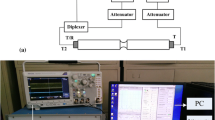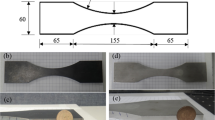Abstract
The deterioration conditions of nuclear power plants and chemical plants have raised deep concerns about the safety of high-risk structures. The safety of a structure can be secured by evaluations of breakages and lifespan in the early stage. Therefore, the material condition of a structure needs to be estimated. A nonlinear ultrasonic evaluation method is reportedly more sensitive on microscopic changes of a material than a linear evaluation method. Therefore, the nonlinear ultrasonic technique based on ultrasonic nonlinearity is considered a promising method of evaluation for breakages and lifespan. This study measured the changes in nonlinear parameters by using a nonlinear ultrasonic method, observed the microstructure of a heated material, and analyzed the relation between the size of the microstructure and the changes in the nonlinear parameters.
Similar content being viewed by others
References
Kim, G. D. and Loh, B. G., “Direct Machining of Micro Patterns on Nickel Alloy and Mold Steel by Vibration Assisted Cutting,” Int. J. Precis. Eng. Manuf., Vol. 12, No. 4, pp. 583–588, 2011.
Pédron, J. P. and Pineau, A., “The Effect of Microstructure and Environment on the Crack Growth Behaviour of Inconel 718 Alloy at 650°C under Fatigue, Creep and Combined Loading,” Materials Science and Engineering, Vol. 56, No. 2, pp. 143–156, 1982.
Jeong, H., Lee, J. S., and Bae, S. M., “Defect Detection and Localization in Plates Using a Lamb Wave Time Reversal Technique,” Int. J. Precis. Eng. Manuf., Vol. 12, No. 3, pp. 427–434, 2011.
Jhang, K. Y., “Nonlinear Ultrasonic Techniques for Nondestructive Assessment of Micro Damage in Material: A Review,” Int. J. Precis. Eng. Manuf., Vol. 10, No. 1, pp. 123–135, 2009.
Kim, J. Y., Jacobs, L. J., Qu, J., and Littles, J. W., “Experimental characterization of fatigue damage in a nickel-base superalloy using nonlinear ultrasonic waves,” Journal of the Acoustical Society of America, Vol. 120, No. 3, pp. 1266–1273, 2006.
Choi, Y. H., Kim, H. M., Jhang, K. Y., and Park, I. K., “Application of Non-linear Acoustic Effect for Evaluation of Degradation of 2.25Cr-1Mo Steel,” Journal of the Korean Society for Nondestructive Testing, Vol. 22, No. 2, pp. 170–176, 2002.
Ogi, H., Hirao, M., and Aoki, S., “Noncontact monitoring of surface-wave nonlinearity for predicting the remaining life of fatigued steels,” Journal of Applied Physics, Vol. 90, No. 1, pp. 438–442, 2001.
Herrmann, J., Kim, J.-Y., Jacobs, L. J., Qu, J., Littles, J. W., and Savage, M. F., “Assessment of Material Damage in a Nickel-Base Superalloy Using Nonlinear Rayleigh Surface Waves,” Journal of Applied Physics, Vol. 99, No. 12, Paper No. 124913, 2006.
Li, W., Lee, J., and Cho, Y., “Study of Ultrasonic Nonlinearity in Heat-Treated Material,” Transactions of the KSME A, Vol. 34, No. 6, pp. 751–756, 2010.
Author information
Authors and Affiliations
Corresponding author
Rights and permissions
About this article
Cite this article
Li, W., Hyun, S. & Cho, Y. Characteristics of ultrasonic nonlinearity by thermal fatigue. Int. J. Precis. Eng. Manuf. 13, 935–940 (2012). https://doi.org/10.1007/s12541-012-0121-4
Received:
Accepted:
Published:
Issue Date:
DOI: https://doi.org/10.1007/s12541-012-0121-4




